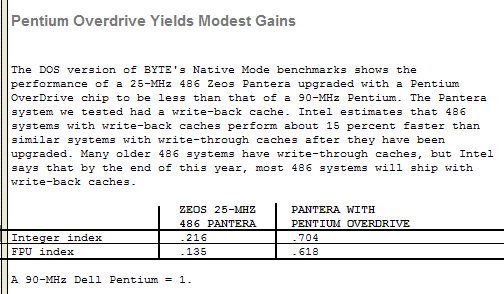| Intel's Pentium OverDrive processor is a compromise
design. It puts a rocket in your socket, all right, but
the upgrade socket has a 32-bit, 486-style I/O bus — not
the faster, wider, 64-bit bus of a regular Pentium. The
resulting bottleneck keeps the Pentium OverDrive from
delivering as much performance as you might expect (see
the BYTE benchmark table). Still, it's faster than a 486, and Intel did a few things to compensate for the narrower bus. For instance, the Pentium OverDrive has twice as much primary cache as a regular Pentium (32 KB versus 16 KB), optimized cache lines, and a 5-to-2 core-to-bus clock-speed ratio that runs the CPU at 83 MHz in a 33-MHz system or at 63 MHz in a 25-MHz system. To keep the OverDrive cool — it runs much hotter than a 486 — Intel strapped a high-reliability fan on the chip. A small TSR program monitors the fan's rpm rate; if the fan slows down or stops, an error message pops up on the screen, and the CPU throttles back its clock speed to prevent a meltdown. With a street sticker price of about $400, the Pentium OverDrive is a reasonable upgrade if your 486 system is otherwise adequate. You will also spend less time upgrading your office if you've kept good records about whose 486 systems are Pentium-upgradable — and which ones are not. But with prices of full-fledged Pentium systems plunging, you might be better off saving your money for a whole new computer. Pentium Overdrive Yields Modest Gains
 The DOS version of BYTE's Native Mode benchmarks shows the performance of a 25-MHz 486 Zeos Pantera upgraded with a Pentium OverDrive chip to be less than that of a 90-MHz Pentium. The Pantera system we tested had a write-back cache. Intel estimates that 486 systems with write-back caches perform about 15 percent faster than similar systems with write-through caches after they have been upgraded. Many older 486 systems have write-through caches, but Intel says that by the end of this year, most 486 systems will ship with write-back caches. Copyright 1994-1998 BYTE |